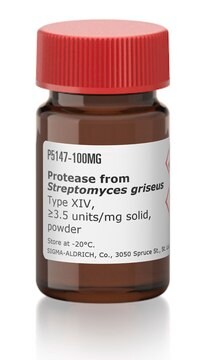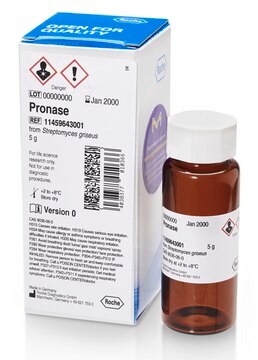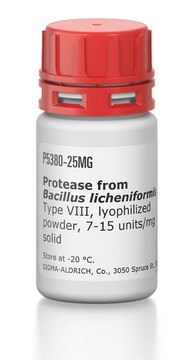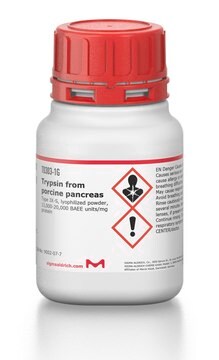53702
Pronase® Protease, Streptomyces griseus
Sinonimo/i:
Pronase® powder
Autenticatiper visualizzare i prezzi riservati alla tua organizzazione & contrattuali
About This Item
Prodotti consigliati
Forma fisica
lyophilized
Livello qualitativo
Attività specifica
≥45,000 proteolytic units/g dry wt
Produttore/marchio commerciale
Calbiochem®
Condizioni di stoccaggio
OK to freeze
desiccated (hygroscopic)
Solubilità
water: 10 mg/mL
Condizioni di spedizione
ambient
Temperatura di conservazione
2-8°C
Descrizione generale
A non-specific protease liquefies mucins and digests proteins to free amino acids. Can be used to isolate living chondrocytes. Most active at neutral pH, but it is stable over a wide pH and temperature range. Has an optimal pH of 7.5. Note: 1 KU = 1000 units.
A non-specific protease liquefies mucins and digests proteins to free amino acids. Can be used to isolate living chondrocytes. Most active at neutral pH, but stable over wide range of pH and temperature. Note: 1KU = 1000 units.
Note: 1 KU = 1000 units.
Attenzione
Toxicity: Harmful (C)
Definizione di unità
One unit is defined as the amount of enzyme that will liberate a digestion product equivalent to 25 µg of tyrosine per min at 40°C, pH 7.5.
Stato fisico
Lyophilized from a solution containing calcium acetate as a stabilizer.
Ricostituzione
Following reconstitution, store in the refrigerator (4°C). Stock solutions are stable for 24 h at 4°C.
Altre note
Narahashi, Y., et al. 1968. J. Biochem. 64, 427.
Note legali
CALBIOCHEM is a registered trademark of Merck KGaA, Darmstadt, Germany
PRONASE is a registered trademark of Merck KGaA, Darmstadt, Germany
Avvertenze
Danger
Indicazioni di pericolo
Consigli di prudenza
Classi di pericolo
Eye Irrit. 2 - Resp. Sens. 1 - Skin Irrit. 2 - STOT SE 3
Organi bersaglio
Respiratory system
Codice della classe di stoccaggio
11 - Combustible Solids
Classe di pericolosità dell'acqua (WGK)
WGK 2
Certificati d'analisi (COA)
Cerca il Certificati d'analisi (COA) digitando il numero di lotto/batch corrispondente. I numeri di lotto o di batch sono stampati sull'etichetta dei prodotti dopo la parola ‘Lotto’ o ‘Batch’.
Possiedi già questo prodotto?
I documenti relativi ai prodotti acquistati recentemente sono disponibili nell’Archivio dei documenti.
I clienti hanno visto anche
W N Ross et al.
The Journal of neuroscience : the official journal of the Society for Neuroscience, 4(3), 659-672 (1984-03-01)
Optical techniques using voltage-sensitive dyes were used to record electrical events simultaneously from many positions on certain neurons of the barnacle supraesophageal ganglion. By signal-averaging, recordings with good signal-to-noise ratios and time resolution were obtained from fine dendritic processes as
T E Davis et al.
Infection and immunity, 15(3), 978-987 (1977-03-01)
Enzymes capable of hydrolyzing cell walls of Blastomyces dermatitidis and chemotypes I and II of Histoplasma capsulatum were prepared in the laboratory or obtained from commercial sources. They included chitinases, beta-1,3-glucanases, beta-1,6-glucanase, and Pronase. Monosaccharides and disaccharides of glucose released
Saurabh Dahiya et al.
Human molecular genetics, 20(22), 4345-4359 (2011-08-19)
Matrix metalloproteinases (MMPs) are a group of extracellular proteases involved in tissue remodeling in several physiological and pathophysiological conditions. While increased expression of MMPs (especially MMP-9) has been observed in skeletal muscle in numerous conditions, their physiological significance remains less-well
M Tsacopoulos et al.
The Journal of neuroscience : the official journal of the Society for Neuroscience, 17(7), 2383-2390 (1997-04-01)
Glial cells transform glucose to a fuel substrate taken up and used by neurons. In the honeybee retina, photoreceptor neurons consume both alanine supplied by glial cells and exogenous proline. Ammonium (NH4+) and glutamate, produced and released in a stimulus-dependent
S Kästner et al.
The journal of histochemistry and cytochemistry : official journal of the Histochemistry Society, 48(8), 1079-1096 (2000-07-18)
Satellite cells are the myogenic precursors in postnatal muscle and are situated beneath the myofiber basement membrane. We previously showed that fibroblast growth factor 2 (FGF2, basic FGF) stimulates a greater number of satellite cells to enter the cell cycle
Il team dei nostri ricercatori vanta grande esperienza in tutte le aree della ricerca quali Life Science, scienza dei materiali, sintesi chimica, cromatografia, discipline analitiche, ecc..
Contatta l'Assistenza Tecnica.













